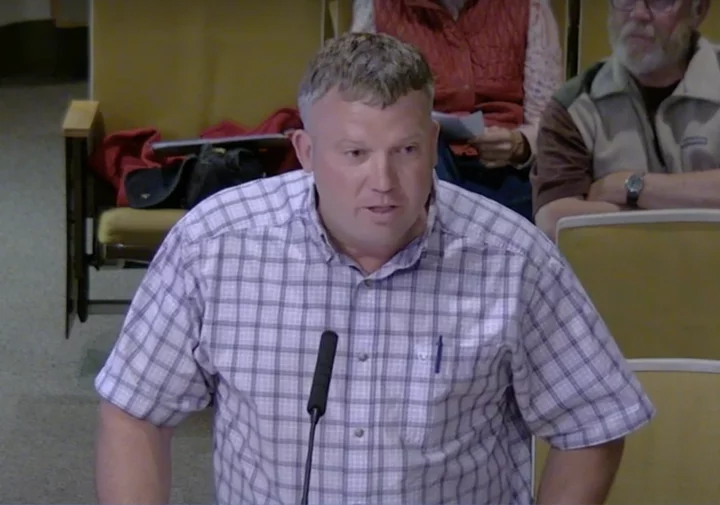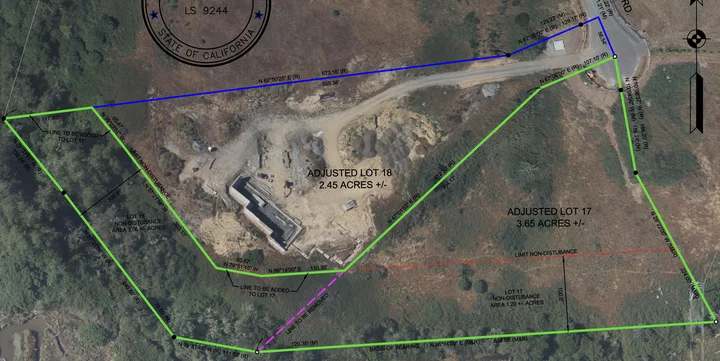Local developer and owner of civil engineering firm Pacific Affiliates addresses the Planning Commission. | Screenshot.
###
Travis Schneider’s massive, half-built dream home will be demolished.
That’s the big takeaway from last night’s meeting of the Humboldt County Planning Commission — well, that and the fact that Schneider appeared in person to offer an emotional apology to those impacted by the numerous permit violations he accumulated while attempting to build a mega-mansion in the Walker Point subdivision, atop a hill overlooking the Fay Slough Wildlife Area.
The six members present (with Commissioner Thomas Mulder absent) unanimously approved modifications to a Coastal Development Permit and special permits, which will allow the local developer and business owner to remove the foundation and framing of a structure that dramatically exceeded its permitted size while violating numerous other conditions of the permit.
Senior Planner Cliff Johnson recapped some of those violations while introducing the agenda item. As originally approved in 2018, the permit called for an 8,000-square-foot single-family residence with attached cellar and garage. The structure Schneider framed up was nearly 21,000 square feet.
Schneider also built an un-permitted access road within a wetland setback area; built a portion of the house within a 100-foot wetland setback; started construction without a building permit; failed to get a required septic permit; and removed vegetation, including native California blackberries, from the wetland area, which is home to a designated archeological site from a historical Wiyot village.
The un-permitted access road. | Screenshot from Thursday’s meeting.
###
After learning about some of these violations, the county issued a stop work order on December 27, 2021, and three Wiyot-area tribes — the Blue Lake Rancheria, the Bear River Band of the Rohnerville Rancheria and the Wiyot Tribe — were called in for consultation. [DISCLOSURE: The Blue Lake Rancheria is a minority owner in the Outpost’s parent company, Lost Coast Communications, Inc.]
The project has been mired in controversy ever since, and while Schneider initially expressed optimism that he could resolve the permit violations, his quagmire of permit violations proved impossible to escape. By building inside the 100-foot wetland setback, the project automatically came under the jurisdiction of the California Coastal Commission, whose staff cautioned the county that it wouldn’t take the violations lightly.
“After further review and consultation with the California Coastal Commission, we’ve determined that there is no way for this residence to be permitted … ,” Johnson said at last night’s meeting.
Facing daily fines of $40,000, Schneider agreed in April to tear down the home and remediate the property to its pre-construction condition. As part of last night’s deliberations, the commission considered a lot-line adjustment between the two parcels on which the project was being built.
According to a staff report, Schneider intends to convey one of the two redrawn parcels (the larger of the two, at 3.65 acres, delineated in green below) to a land-holding agency for the benefit of the three Wiyot-area tribes.
Map of the proposed new lot lines. | Image via County of Humboldt.
###
Commissioner Peggy O’Neill asked whether the property owner could build a new home on the other parcel in the future. Johnson said yes, though the owner would have to reapply for a new permit.
Prior to deliberations from the commission, Schneider spoke from the lectern, his voice trembling as he apologized and spoke about his intention to “be a positive member” of this community by providing housing to others.
The video below is queued up to the start of his apology:
Earlier in his comments, Schneider noted that the permit modifications, as written, would require him to perform all remediation work, including removal of the structure and regrading the property, by October 20, which he said would be “very challenging.” He asked for six months after receiving all necessary approvals — or a minimum of five months in the dry season — to complete that work.
Planning and Building Director John Ford said it would make sense for the site to be stabilized during the wet-weather winter months and for Schneider to be given time next year to remove the un-permitted fill material that was brought onto the property.
“I think that’s agreeable,” O’Neill said. “You don’t want to do more damage by working in the wet season.”
The commission agreed to modify the proposed motion, giving Schneider until July 31 of next year to fully remediate the property and requiring him to stabilize the site through the winter. A sentence was later added saying Ford could extend the deadline if there are delays due to “natural circumstances.”
Commissioners Iver Skavdal and Noah Levy both acknowledged Schneider’s apology with appreciation. O’Neill made a motion to adopt the resolution. Skavdal seconded, and the motion passed unanimously.
###
PREVIOUSLY:
- Heated Meeting Sparks Accusations of Dishonesty and Discrimination, Opening Rift Between Tribes and Humboldt County Planning Commission
- Despite Silence From Tribes, Mega-Home Builder Optimistic Ahead of Tonight’s Continued Planning Commission Hearing to Address Permit Violation Fallout
- After Rebukes and Apologies for Bongio’s ‘Disrespectful’ Comments, Planning Commission Defers Decision on Mega-Home Permits
- County Supes to Consider Censure of Planning Commission Chair Alan Bongio for Inappropriate Conduct
- Bohn Makes the Motion, Supes Unanimously Censure Bongio for Racist Remarks, Move to Remove Him as Chair of Planning Commission
- A Tour Through the Half-Built Dream Mansion of Travis Schneider, Who Remains Hopeful Amid Mounting Permit Problems
- Alan Bongio, Embattled Humboldt County Planning Commissioner, Resigns
- Planning Commission Set to Rescind Permit for Controversial Schneider Home as Developer Prepares to Tear it Down, Remediate Damage to Property



CLICK TO MANAGE